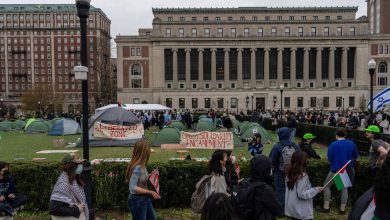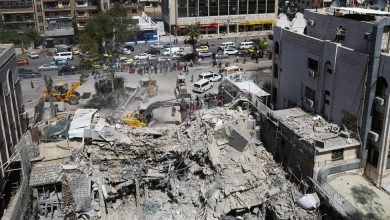Putin Spins a Conspiracy Theory That Ukraine Is on a Path to Nuclear Weapons

MUNICH — When Ukraine gave up a huge arsenal of nuclear weapons left on its territory after the collapse of the Soviet Union, it famously struck a deal with Washington, London and Moscow, trading the weapons for a guarantee of its security and borders.
Not surprisingly, the Ukrainian government is wondering what happened to that guarantee.
But President Vladimir V. Putin of Russia has a very different complaint: He is spinning out a conspiracy theory — perhaps as a pretext to seize the whole country — that Ukraine and the United States are secretly plotting to put nuclear weapons back into the country.
Mr. Putin’s arguments occupied a third of his speech to the Russian people on Monday, when he made a series of bizarre charges that “Ukraine intends to create its own nuclear weapons, and this is not just bragging.” Then he built a second case that the United States is converting its missile defenses into offensive weapons, and has plans to put nuclear weapons on Ukrainian territory.
Ukraine gave up a huge arsenal of nuclear weapons left over by the Soviet Union in the early 1990s, and used the fuel from its blended-down warheads to drive its nuclear power plants. Today Ukraine does not even have the basic infrastructure to produce nuclear fuel, though Mr. Putin made the dubious claim that it could pick that talent up quickly.
For their part, American officials have said repeatedly that they have no plans to place nuclear weapons in the country — and never have, especially since Ukraine is not a member of NATO.
But that has not stopped Mr. Putin from building a hypothetical case that all those things could happen, some day, theoretically putting Moscow at risk. He built on the theme at another news conference on Tuesday, embracing a series of conspiracy theories that, added together, may well create the pretext to seize the entire country.
“If Ukraine acquires weapons of mass destruction, the situation in the world and in Europe will drastically change, especially for us, for Russia,” he said. “We cannot but react to this real danger, all the more so since, let me repeat, Ukraine’s Western patrons may help it acquire these weapons to create yet another threat to our country.”
Mr. Putin has made such arguments before, of course, but usually as asides — not as the justification for urgent action. And it was starkly different from the tone Moscow was taking 30 years ago, when Russian nuclear scientists were being voluntarily retrained to use their skills for peaceful purposes and nuclear weapons were being removed from Ukraine, Belarus and Kazakhstan with funds provided by American taxpayers.
“It is a great tragedy,” said Rose Gottemoeller, who negotiated the New START arms control treaty with Russia and is now at Stanford University. “Putin is so steeped in his own grievances that he does not remember how we worked together so closely — Americans, Ukrainians and Russians — to ensure the breakup of the Soviet nuclear arsenal did not lead to the creation of three new nuclear weapons states.”
In fact, Mr. Putin is now using the key agreement from that era, called the Budapest Memorandum, to bolster his case. The memorandum — signed by Ukraine, the United States, Britain and Russia — enshrined the central bargain: Ukraine would surrender the entire nuclear arsenal left inside its territory, and in return the other three nations would all guarantee Ukraine’s security and the integrity of its borders. (While Ukraine had physical control of the weapons, the launch authority for them had remained in the hands of the Russians.)
Yet the memorandum never detailed what that security guarantee entailed, and there was no promise of military assistance in the event of an attack. But Mr. Putin blatantly violated that accord when he annexed Crimea in 2014 and did so again on Monday when he recognized the two separatist republics, essentially claiming that they were no longer part of Ukraine.
He said this week that he was incensed that Ukraine’s president, Volodymyr Zelensky, was publicly talking about reconsidering the memorandum. Mr. Zelensky’s complaint, voiced at the Munich Security Conference last weekend, is that the “guarantee” is proving no guarantee at all against a nation with Russia’s powers of coercion.
Mr. Putin argued that if Ukraine was questioning the memorandum, it must want its own nuclear arsenal.
“We believe the Ukrainian words are directed at us,” Mr. Putin said at a news conference on Tuesday with the president of Azerbaijan. “And we heard them. They have wide nuclear competency from Soviet times, developed nuclear industry, they have schools, everything they need to move quickly.”
Perhaps recognizing that he might be over-describing the threat, Mr. Putin said: “They don’t have one thing — a uranium enrichment program. But that’s a technical question. For Ukraine it’s not an unsolvable problem; it’s easy to solve it.”
Certainly other countries have solved the problem, including Pakistan, North Korea, Iran, Israel and India. But it is a lengthy, enormously complex process. Iran has been at it for two decades now, and still does not have a nuclear weapon, according to Western intelligence assessments. (A new agreement to restrain Iran’s activities, and restore the 2015 nuclear deal, is expected to be announced in the coming weeks — and officials say Russia, a party to the original deal, has been helpful in the negotiations.)
Mr. Putin also complained that Ukraine has “the delivery vehicles for such weapons,” and here he is on safer ground. An old missile plant, a remnant of the Soviet days, has kept going — and was at the center of a controversy a few years ago about whether its designs ended up in the hands of the North Koreans. (Ukraine’s president at the time, Petro O. Poroshenko, denied it.) Mr. Putin acknowledged that Ukraine’s current arsenal does not have the reach to hit Moscow. But with the help of NATO and the West, he said, “it is only a matter of time.”
Understand How the Ukraine Crisis Developed
How it all began. Antagonism between Ukraine and Russia has been simmering since 2014, when the Russian military crossed into Ukrainian territory, after an uprising in Ukraine replaced their Russia-friendly president with a Western-facing government. Russia annexed Crimea and inspired a separatist movement in the east. A cease-fire was negotiated in 2015, but fighting continued.
Russia’s interests in Ukraine. Russia has been unnerved by NATO’s eastward expansion and Ukraine’s growing closeness with the West. While Ukraine is not part of the European Union or NATO, it receives financial and military aid from the United States and Europe.
How the recent tensions began. In recent months Russia has built up a military presence near its border with Ukraine. U.S. officials say they have evidence of a Russian war plan that envisions an invasion force of 175,000 troops.
Failed diplomatic efforts. The United States, NATO and Russia have been engaged in a whirlwind of diplomacy to prevent an escalation of the conflict. In December, Russia put forth a set of demands, including a guarantee that Ukraine would never join NATO. The West dismissed those demands and threatened economic consequences.
The U.S.’s role. In February, the United States began warning that a full-scale invasion might be days away. Some 8,500 American troops have been placed on “high alert” for possible deployment to Eastern Europe, though President Biden has made clear that the United States would not send troops to fight for Ukraine.
Moscow asserts its power. On Feb. 21, President Vladimir V. Putin of Russia signed decrees recognizing two pro-Russian breakaway regions in eastern Ukraine and ordering troops to carry out “peacekeeping functions” in those areas. In an emotional speech announcing the move, the Russian president laid claim to all of Ukraine as a country “created by Russia.”
What is next? Mr. Putin’s actions appear to be laying the groundwork for wider intervention in Ukraine. But the economic damage of Western-imposed sanctions, and the death toll of a war, might be too great a cost for Moscow to stomach.
Then he turned his ire to Washington itself, building on the argument that it must get all of its nuclear weapons out of Europe — and certainly out of the former Soviet bloc nations that joined NATO. He claimed that an antimissile system placed in Poland and Romania — and designed to protect against Iran — could secretly be converted into an offensive system that would threaten Russia.
“In other words, the allegedly defensive U.S. missile defense system is developing and expanding its new offensive capabilities,” Mr. Putin said. He made no mention of an offer from the United States to negotiate a new arms control agreement that would limit the number of sites on both sides.
Again, he said, “it is only a matter of time” before Ukraine is admitted to NATO, and becomes the launching pad for potential attacks on Russia.
“We clearly understand that given this scenario, the level of military threats to Russia will increase dramatically, several times over,” Mr. Putin said. “And I would like to emphasize at this point that the risk of a sudden strike at our country will multiply.”
His message seemed clear: The only way for Ukraine to avoid becoming a platform for American weapons would be to take it over, or have it run by a friendly government.



